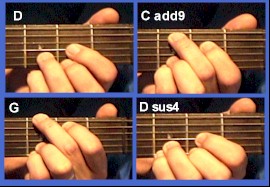Scroll through the lesson and click on notation/video/audio links to load the interactive players.
Please subscribe to get full access to all lessons for only $7.95/month PLUS 1 week free trial.

Riff Interactive lessons are
LESS expensive and
MORE interactive than alternatives!
More Info
|
|

Jam Sessions - All
Blues Styles
Lesson 2 - Blues in D Lesson
Sample
Lyle:
Ready to jam?! In this lesson you'll learn a couple different rhythm riffs and 3
different solos made from 3 different scales. Here's your jam
track:
Jam Track -
Blues in D
Lyle:
Hare's the chords used in this jam:
chords

chords
Lyle:
This is a classic progression used in the blues/rock style. Try this with either
super clean or slightly distorted tone, add chorus and a little bit of reverb.
Lyle:
Notice the Cadd9 and G chords both use the 3rd and 4th fingers, so does the
Dsus4 chord. Here's how I suggest playing the rhythm
part:
rhythm riff
1
rhythm riff
1
Lyle:
Here's another way of playing the 3 basic chords. This is what I like to call
the "Hendrix rhythm style" type of riff. Your index finger is used to bar across
the 5th, 4th, and 3rd strings.
rhythm riff 2
rhythm riff
2
chord
chart

Lyle: All three chords are related to each other.
They all happen to be in the key of G major. D is the V chord, C is the IV chord
and G is the I chord in G. Since the chord progression starts and ends on the D
chord, you should center your soloing around the D by using D pentatonic
scales.
Lyle: Since the D chord is NOT a minor chord, the
D major pentatonic would be my first choice of scales to
use:
D major
pentatonic
Lyle:
Here's a little solo I made from this
scale:
solo with
major pentatonic
solo
with major pentatonic
Lyle:
Your turn! Try playing the D major pentatonic scale and this solo example along
to the looping jam track.
PaulB: that's what I've been doing
:)
Lyle:
I can hear ya!
Lyle: The major pentatonic against the major
chord gives you a strong sound. To get a blues-ier sound, try the minor
pentatonic against the major chord.
Dm pentatonic
walker: hard
to play at that speed at the end
Lyle: Thought I'd give some of you a little
challenge.
Support: You can use the "tempo" button to slow
it down and select smaller sections of the notation with the mouse to work
on...
walker:
ok
Lyle:
Good idea Support, thanks. You can 1) slow the TAB down, 2) slow the jam track
down.
Lyle: Now listen to this solo. It is the same
thing only using the D minor pentatonic. Notice it has a raunchier, darker, and
bluesy tone to the over-all sound:
solo with minor pentatonic
solo with minor
pentatonic
Lyle:
So you can use both the major and minor pentatonic scales against this blues jam
in D.
D major and minor pentatonics
dh: The chord
arrangement is close to Bon Jovi "Wanted Dead or Alive"
Lyle: dh,
yes
Lyle:
There is another good scale you can use to jam with, the D mixolydian
mode:
D Mixolydian
mode
Lyle:
The mixolydian mode is the dominant scale. It is the 5th mode of the G major
scale.
Lyle: It has 7 different tones in it, making it
more melodic sounding than the 5 tone pentatonic scales
Lyle: Here's an example:
solo with mixolydian
solo with
mixolydian
Lyle:
Try playing all 3 solo examples back to back along to the jam track. This will
help train your ear to recognize the tone difference between the three scales
used.
Lyle: Here's a video
example:
video
example with improv
Lyle:
Any questions?
dh: Is there a certain chord that makes it easier to
switch from the major to the minor pent?
Lyle: dh, the V / dominant chord like the way it
was used in this jam:
chord chart

Lyle: D is the V chord, C is the IV chord and G
is the I chord in G.
Lyle: So when you have the chance to play a jam
against the V chord like this, both major and minor pentatonics can work well
with each other.
Lyle: Good question dh.
Lyle:
Let's take a break for now.
|
<< load notation from left
|
|
<< load audio from left
|
<< load audio from left
|